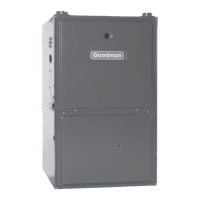
Do you have a question about the Goodman GMS9 and is the answer not in the manual?
Steps to prevent damage to electronic components from static discharge.
General considerations for furnace placement and surrounding environment.
Instructions for securely suspending the furnace from rafters or joists.
Procedure for removing an existing furnace and venting system.
Recommendations for optimal thermostat placement in the building.
Minimum clearances required around the furnace for safety and accessibility.
General considerations applicable to horizontal furnace installations.
Instructions for installing and routing condensate drain traps and lines.
Guidance on ensuring the furnace is properly leveled for optimal operation.
Details on using alternate connection points for vent/flue and combustion air.
General warnings and requirements for vent/flue and combustion air piping.
Explanation of dual certification for non-direct and direct vent furnace installations.
Specifications for PVC and ABS materials and joining methods for venting.
Best practices for installing vent/flue and combustion air piping for safe operation.
Restrictions and guidelines for vent/flue and combustion air termination locations.
Specific venting requirements for installations in Canada.
Details on standard connections for vent/flue and combustion air piping.
Instructions for connecting vent/flue pipe using provided couplings and clamps.
Instructions for connecting combustion air intake pipe for direct and non-direct vent systems.
Information on alternative side panel locations for piping connections.
Steps for using the alternate vent/flue location for piping connections.
Steps for using the alternate combustion air intake location for piping connections.
Details on vent/flue pipe requirements for non-direct vent installations.
Table specifying allowable vent/flue pipe lengths and elbow counts.
Guidelines for terminating vent/flue pipes vertically and horizontally.
Details on vent/flue and combustion air piping requirements for direct vent systems.
Clearance requirements for terminating multiple direct vent furnaces.
Instructions for concentric vent termination using a specific kit.
General information on condensate generation and drainage requirements.
Specific steps for connecting drain hoses in upright furnace installations.
Instructions for connecting drain hoses to standard side outlets in upright installations.
Instructions for connecting drain hoses when using the alternate vent/flue outlet.
Guidance for mounting the drain trap to the side panel in upright installations.
Instructions for connecting drain hoses in horizontal furnace installations.
Guidance for mounting the drain trap to the side panel in horizontal installations.
Wiring instructions for connecting the thermostat to the furnace control module.
Instructions for wiring accessories like humidifiers and air cleaners to the furnace.
Specific instructions for connecting a 24-volt humidifier to the furnace.
Information on adjusting for high altitude operation, including orifice kits.
Instructions and warnings for converting the furnace to propane gas.
Details on the furnace's 24-volt gas valve and its conversion.
General guidelines and precautions for connecting the gas piping.
Instructions for connecting gas piping to the standard inlet hole.
Instructions for connecting gas piping to the alternate inlet hole.
Procedure for leak testing gas connections before operation.
Guidelines for propane gas tanks, piping, and safety devices.
Requirements for designing duct systems for proper airflow and furnace performance.
Crucial information regarding filter usage, selection, and maintenance for furnace operation.
Possible filter locations and types for upright furnace installations.
Filter installation requirements for horizontal furnace configurations.
Instructions for setting the heat anticipator on the room thermostat.
Procedure for priming the condensate drain trap before furnace startup.
Pre-startup checks, leak testing, and kit verification before furnace operation.
Step-by-step instructions for safely starting the furnace for the first time.
Procedure for measuring and verifying the furnace's gas supply pressure.
Specific instructions for measuring inlet pressure on the 36F22 gas valve.
Specific instructions for measuring inlet pressure on the 36G22 gas valve.
Procedure for measuring and adjusting the gas manifold pressure.
Method for measuring the natural gas input rate to the furnace.
Procedure for measuring and adjusting the temperature rise across the heat exchanger.
Instructions for selecting and adjusting circulator blower speeds for optimal performance.
Sequence of events when power is first applied to the furnace.
Step-by-step operation of the furnace during a heating cycle.
Sequence of operation when the furnace is used in a cooling application.
Operation sequence when only the furnace fan is activated.
Inspection criteria for the burner flame to ensure proper combustion.
Checking the function of the primary limit control for overheating protection.
Description of the electronic control module and its role in safety monitoring.
Details on the primary limit control's location, function, and reset.
Description of auxiliary limit controls for monitoring compartment temperatures.
Description of rollout limit controls for monitoring burner flame.
Explanation of pressure switches and their role in monitoring airflow.
Description of the flame sensor's function in detecting burner flame presence.
Precautions to prevent damage to electronic components from static discharge.
Reference chart to help identify fault codes and their causes.
Methods for resetting the furnace after it enters a lockout condition.
Annual inspection checklist and procedures for the furnace and its components.
Guidance on filter selection, maintenance, and replacement for optimal performance.
Procedures for cleaning heat exchanger flue passages for servicers.
Steps for removing filters located in the bottom return air path.
Steps for removing the filter located in the blower compartment.

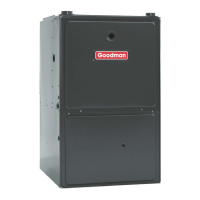
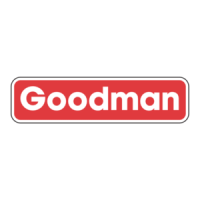
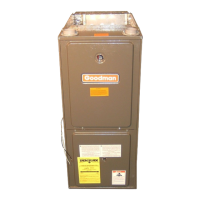
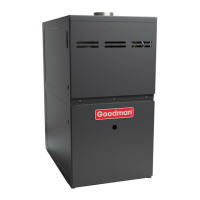
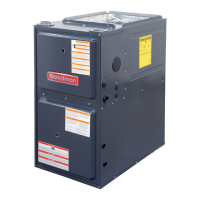






